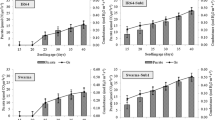Summary
Of the three growth stagesviz., seedling establishment, maximum tillering and flowering, complete submergence of plant at flowering stage was found to be most critical followed by seedling estabilishment and maximum tillering stages. Among the three stages of reproductive growth phase, booting stage was found to be most susceptible to complete submergence followed by flowering and post-flowering. The submergence at booting for 4 days was equally detrimental as that of 6 or 8 days at flowering. Irrespective of the growth stages, the plants subjected to complete submergence showed higher nitrogen content (in plant as well as in grain) as compared to those grown under control conditions (5±2 cm) and increased with the increase in duration of submergence. The P and K contents in the plant decreased under submergence.
Similar content being viewed by others
Literature cited
Alim A, Zaman S M H, Sen J L, Ullah M T and Chowdhury M A 1962 Review of half century of rice research in East Pakistan. East Pakistan Govt. Press, Dacca, 199 p.
Boonwhite C, Klumlekhasing W, Thanasate M, Kupkanchanskul K and Hille Ris Lambers D 1981 Establishing the limits of submergence tolerance. pp 90–91.In Papers for the Deep Water Rice Planning Meeting at the Rice Division of the Dept. of Agri., Bangkhen, Thailand, 99 p.
Chowdhury M A and Zaman S M H 1970 Deepwater rice of East Pakistan. 13th Intl. Rice Commission working party Rice production and Protection. Iran, 1970. Paper IRC/pp 70/VII/6. 20 p.
Ghosh B C 1979 Investigation on suitability of modern rice varieties for flood-prone areas. Ph. D. Thesis, I. I. T., Kharagpur, India.
Ghosh D C and Chatterjee B N 1979 Growth of rice in lowlying land with submergence upto 40 and 100 cm. Indian J. Agric. Sci. 49, 689–702.
Jackson B R, Hille Ris Lambers D and Prechachat C 1982 Development of deep water rice varieities and breeding materials for South and Southeast Asian countries. pp 19–28In Proc. of the 1981 International Deepwater Rice Workshop. IRRI, Philippines.
Matsushima S 1962 Some experiments on soil water plant relationship in the cultivation of rice. Proc. Crop Sci. Soc. Japan 31 115–121.
Matsushima S and Tanaka T 1966 Life history of rice plant. pp 77–91In Theory and Practice of Growing Rice. Eds. M Matsubayashi et al.. Fuji Publishing Co. Ltd., Tokyo.
Matsushima S and Wada C 1966 Ripening of the rice plant. pp 139–149In Theory and Practice of Growing Rice. Eds M Matsubayashi et al. Fuji Publishing Co. Ltd., Tokyo.
Mazaredo A M and Vergara B S 1982 Physiological differences in rice varieties tolerant of and susceptible to complete submergence. pp 327–342.In Proc. of the 1981 International Deep Water Rice Workshop. IRRI, Philippines.
Palada M 1970 Survival of completely submerged rice plants. M. S. Thesis Univ. Philippines, College of Agric., Los Banos, Philippines 98 p.
Palada M C and Vergara B S 1972 Environmental effects on the resistance of rice seedlings to complete submergence. Crop Sci. 12, 209–212.
Pande H K 1984 Prospects of rainfed lowland rice production in India by 2000 A.D. Central Rice Research Institute, Cuttack, India (mimeo). 51 p.
Reddy M D 1982 Agronomic studies on the constraints and productivity of rice in flood prone and waterlogged areas. Ph. D. Thesis, I.I.T., Kharagpur, India, 193 p.
Yamada N 1959 Physiological basis of resistance of rice plant against overhead flooding (In Japanese, English summary). Bull. Natl. Inst. Agric. Sci. 1, 8–110 p.
Yamada N, Ota Y and Osada A 1955 Physiological studies on resistance of rice plant against overhead flooding (In Japanese, with English summary). Proc. Crop Sci. Soc., Japan 23, 155–161.
Yoshida S 1972, Physiological aspects of grain yield. Annu. Rev. Plant Physiol. 23 437–464.
Yoshida S, Forno D A, Cock J H and Gomez K A 1976 Laboratory manual for physiological studies of rice. International Rice Research Institute, Laguna, Philippines, 83 p.
Author information
Authors and Affiliations
Rights and permissions
About this article
Cite this article
Reddy, M.D., Mittra, B.N. Effect of complete plant submergence at different growth stages on grain yield, yield components and nutrient content of rice. Plant Soil 86, 379–386 (1985). https://doi.org/10.1007/BF02145458
Received:
Revised:
Issue Date:
DOI: https://doi.org/10.1007/BF02145458




